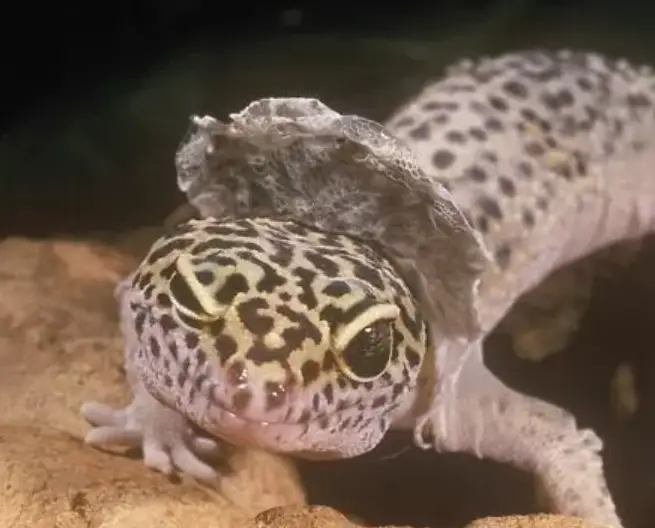Leopard geckos are fascinating pets that require specific care to thrive. If you are a leopard gecko owner, you may have heard of the term “egg-bound.” This refers to a condition where a female leopard gecko is unable to lay her eggs. The condition can be life-threatening to your pet, and it is, therefore, important to know how to prevent it.
In this comprehensive guide, we will discuss everything you need to know about egg-binding in leopard geckos and how to prevent it. We will explore the causes, symptoms and provide you with a step-by-step guide on how to prevent your female leopard gecko from becoming egg-bound.
What is egg-binding, and why does it happen in leopard geckos?
Egg-binding is a condition in which a female reptile is unable to lay her eggs. In some cases, the eggs may become stuck in the female’s reproductive tract, making it difficult or impossible for her to pass them. This can lead to severe health complications, including infection and death.
Egg-binding is a serious condition that requires immediate attention. It can be caused by a variety of factors, including inadequate nesting sites, poor diet, and stress. Female leopard geckos are particularly susceptible to egg-binding because they naturally produce a high number of eggs during breeding season. However, egg-binding can occur at any time of the year, not just during breeding season.
What are the symptoms of egg-binding in leopard geckos?
There are several signs that a female leopard gecko is experiencing egg-binding. These symptoms include:
– Persistent pacing and restlessness
– Straining to pass eggs
– Lack of appetite
– Depression or lethargy
– Swelling of the abdomen or tail
– Difficulty walking or moving
In severe cases, egg-binding can lead to prolapse, where the reproductive organs protrude from the female’s cloaca. This can be life-threatening and requires immediate veterinary care.
How to Prevent Egg-binding in Leopard Geckos?
Prevention is key when it comes to egg-binding in leopard geckos. Here are some tips to help prevent this condition from occurring:
– Provide a suitable nesting site: Female leopard geckos require a suitable place to lay their eggs. This should be a warm, dark, and secure location, such as a nesting box filled with damp substrate or sand.
– Ensure proper nutrition: A diet that is high in calcium and low in phosphorus is crucial for female leopard geckos. Be sure to feed them a variety of insects, such as crickets and mealworms, and provide a calcium supplement.
– Maintain proper temperature and humidity: Leopard geckos need a warm, comfortable environment to thrive. This includes a daytime temperature of around 88-90°F and a nighttime temperature of around 70°F. The humidity level should be between 30-40%.
– Separate males from females: If you have male and female leopard geckos living together, it’s important to separate them during breeding season. This will reduce stress for the females and help prevent egg-binding.
– Keep your gecko healthy: Regular veterinary check-ups and proper hygiene are crucial for keeping your leopard gecko healthy and preventing egg-binding.
Treatments for Egg-binding in Leopard Geckos
If you suspect that your leopard gecko may be experiencing egg-binding, it’s important to seek veterinary care immediately. Time is of the essence when it comes to treating this condition, as a delay can result in serious health complications.
Here are some of the treatments that your veterinarian may recommend:
– Warm water soak: Soaking your leopard gecko in warm water can help relax the muscles and make it easier to pass the eggs. Your veterinarian may also recommend adding a small amount of sugar to the water to aid in digestion.
– Massage: Gently massaging your leopard gecko’s abdomen can help stimulate the muscles and encourage the eggs to move through the reproductive tract.
– Hormone therapy: In some cases, your veterinarian may prescribe a hormone injection to help stimulate egg-laying. This is typically only used in severe cases of egg-binding.
– Surgery: If other treatments are not effective or if your gecko is experiencing complications such as prolapse, surgery may be necessary to remove the eggs and repair any damage to the reproductive tract.
What causes egg-binding in leopard geckos?
Egg-binding is a common problem in female leopard geckos, particularly in those that are kept in captivity. There are several factors that may contribute to this condition, including:
a) Lack of proper nutrition: When a female leopard gecko is not getting enough calcium and vitamins, she may develop egg-binding. A lack of calcium can lead to weak bones, making it difficult for her to push the eggs out.
b) Age: Older leopard geckos have a higher risk of developing egg-binding than younger ones because their muscles have weakened, making it harder to lay eggs.
c) Genetic factors: Some leopard geckos may be genetically predisposed to egg-binding, regardless of their age or diet.
d) Stress: Stress is a leading cause of egg-binding in leopard geckos. Stressful situations can include overcrowding, inadequate housing, and inappropriate temperatures.
2. What are the symptoms of egg-binding in leopard geckos?
The symptoms of egg-binding in leopard geckos are easy to spot. If you notice any of these signs in your pet, it is crucial to seek veterinary help immediately:
a) Lethargy: A lethargic leopard gecko may have trouble moving around or appear weak.
b) Loss of appetite: An egg-bound leopard gecko may lose interest in food.
c) Swollen belly: An egg-bound leopard gecko’s belly may become swollen, which can make it hard to breathe or move.
d) Difficulty walking: Leopards geckos that are egg-bound may experience difficulty walking or standing.
e) Continual straining: An egg-bound leopard gecko may make continual straining motions.
How can I prevent my leopard gecko from becoming egg-bound?
Preventing egg-binding in leopard geckos is possible by implementing several measures, including the following:
a) A proper diet: A balanced and nutritious diet that includes high-quality food, calcium, and vitamin supplements can ensure that your gecko’s bones are strong and healthy. This, in turn, helps prevent egg-binding.
b) Proper temperature and humidity: Leopard geckos need specific temperature and humidity levels to thrive. You should ensure that your pet’s habitat is kept at the optimal temperature of 85°F during the day and 75°F at night, with humidity levels between 30% and 40%.
c) Proper enclosure size: Crowding can cause stress, leading to egg-binding. You should keep your leopard gecko in an enclosure that is large enough to allow her to move around freely.
d) Regular exercise: Leopard geckos need regular exercise to stay healthy and move their muscles. Encourage your pet to move around and use her muscles every day.
e) Correct nesting conditions: Female leopard geckos need a proper nesting box with calcium-rich substrate for laying eggs. Ensure that the substrate is moist, and the nesting box is in a quiet and dark area.
What can I do if my leopard gecko is already egg-bound?
If your leopard gecko is already egg-bound, taking action quickly is essential to her survival. You should seek veterinary care immediately. In the meantime, here are some things you can do:
a) Keep her warm: Keeping your leopard gecko warm can help relax her muscles and make laying easier.
b) Moist environment: A moist environment can help soften the eggs and make laying easier. You can create this by misting her habitat.
c) Massage: Gently massaging your leopard gecko’s abdomen can help stimulate egg-laying.
d) Soak: You can place your leopard gecko in lukewarm water to help her relax and possibly pass the eggs.
Can egg-binding be fatal for leopard geckos?
Yes, egg-binding can be fatal for leopard geckos if not treated promptly. Egg-binding, also known as dystocia, is a condition where a female leopard gecko is unable to lay her eggs due to various reasons, such as inadequate nesting materials, improper temperature, or calcium deficiency.
If left untreated, egg-binding can cause serious health issues for leopard geckos, including egg peritonitis, which is a potentially life-threatening condition where the eggs become trapped inside the body, leading to infection and inflammation. In some cases, egg-binding can also cause a prolapse of the cloaca, which can be very painful and require emergency veterinary treatment.
If you suspect that your leopard gecko is egg-bound, it’s important to seek veterinary attention as soon as possible. A veterinarian will perform a physical examination and may use imaging tests to determine the cause of the problem. Treatment options may include providing supplemental heat and humidity, administering medication to help the gecko pass the egg, or surgery to remove the egg if necessary.
Final thoughts
Egg-binding is a common condition among female leopard geckos and can be life-threatening if not treated promptly. As a pet owner, it is essential to take preventative measures to avoid egg-binding altogether. This includes proper nutrition, housing, temperature, humidity, exercise, and nesting conditions. If your pet is already egg-bound, prompt veterinary intervention is necessary to ensure her safety and wellbeing.
In conclusion, preventing egg-binding in leopard geckos is a matter of good husbandry and understanding your pet’s needs. By following the tips mentioned here, you can help your leopard gecko live a long, healthy life.







